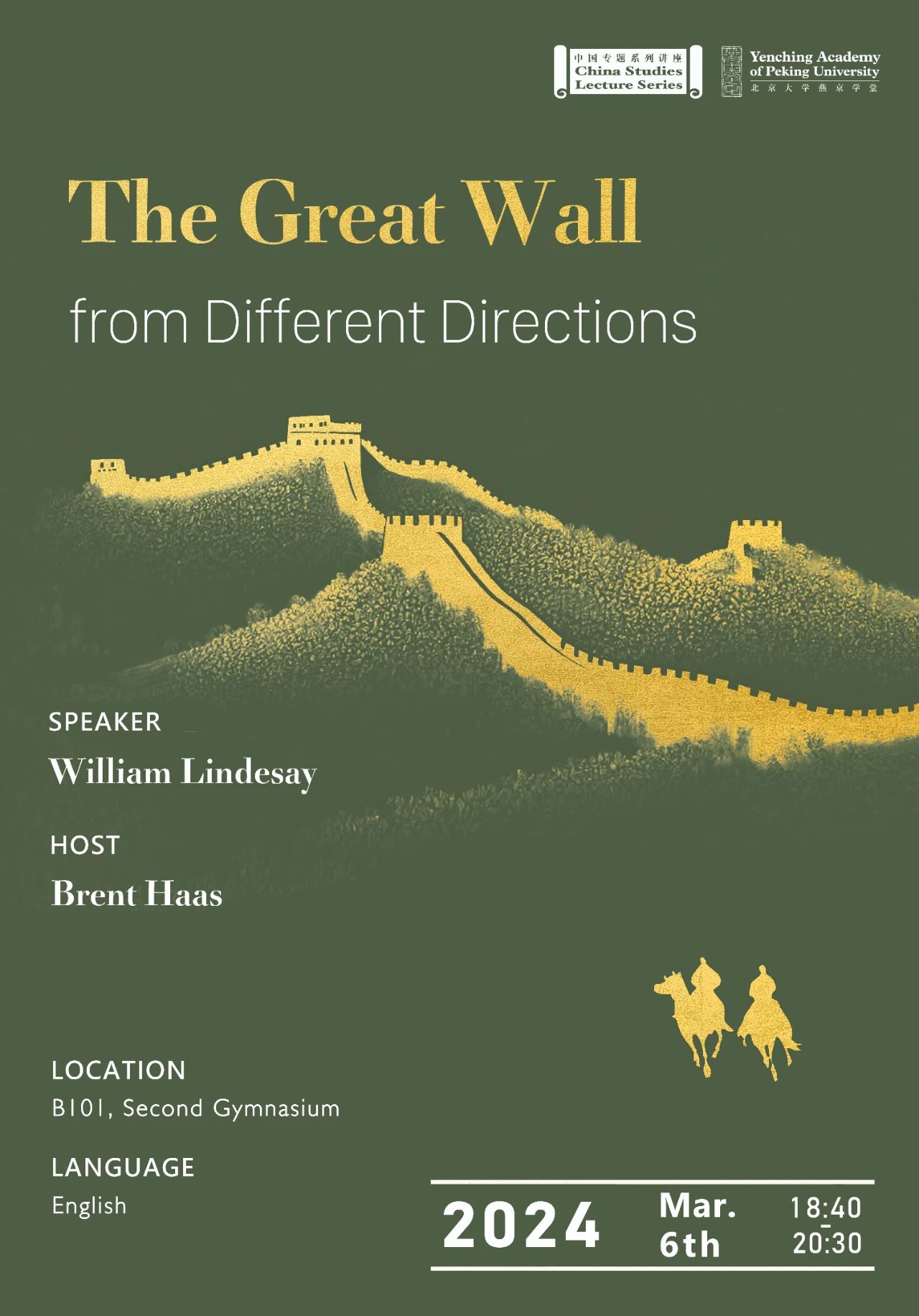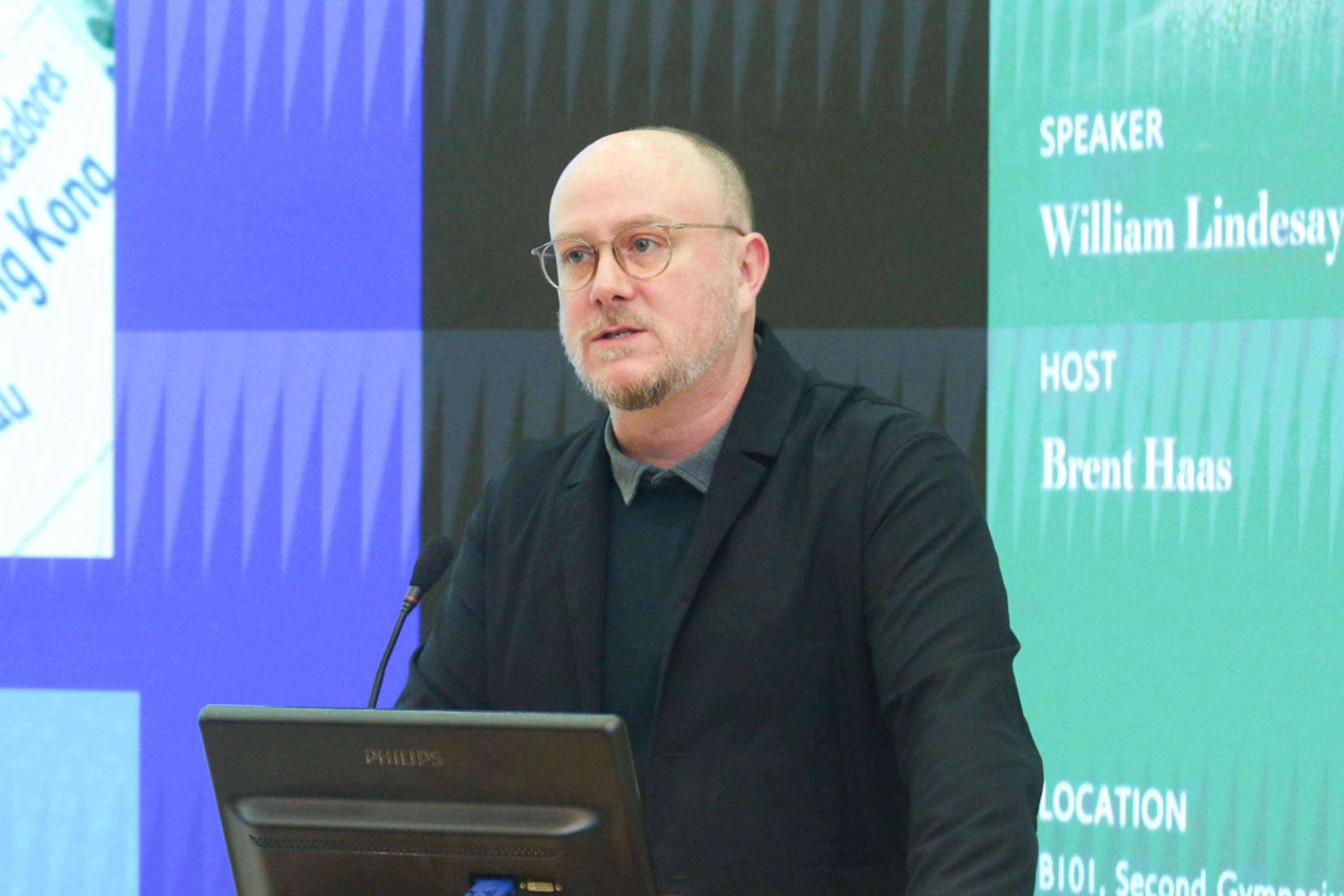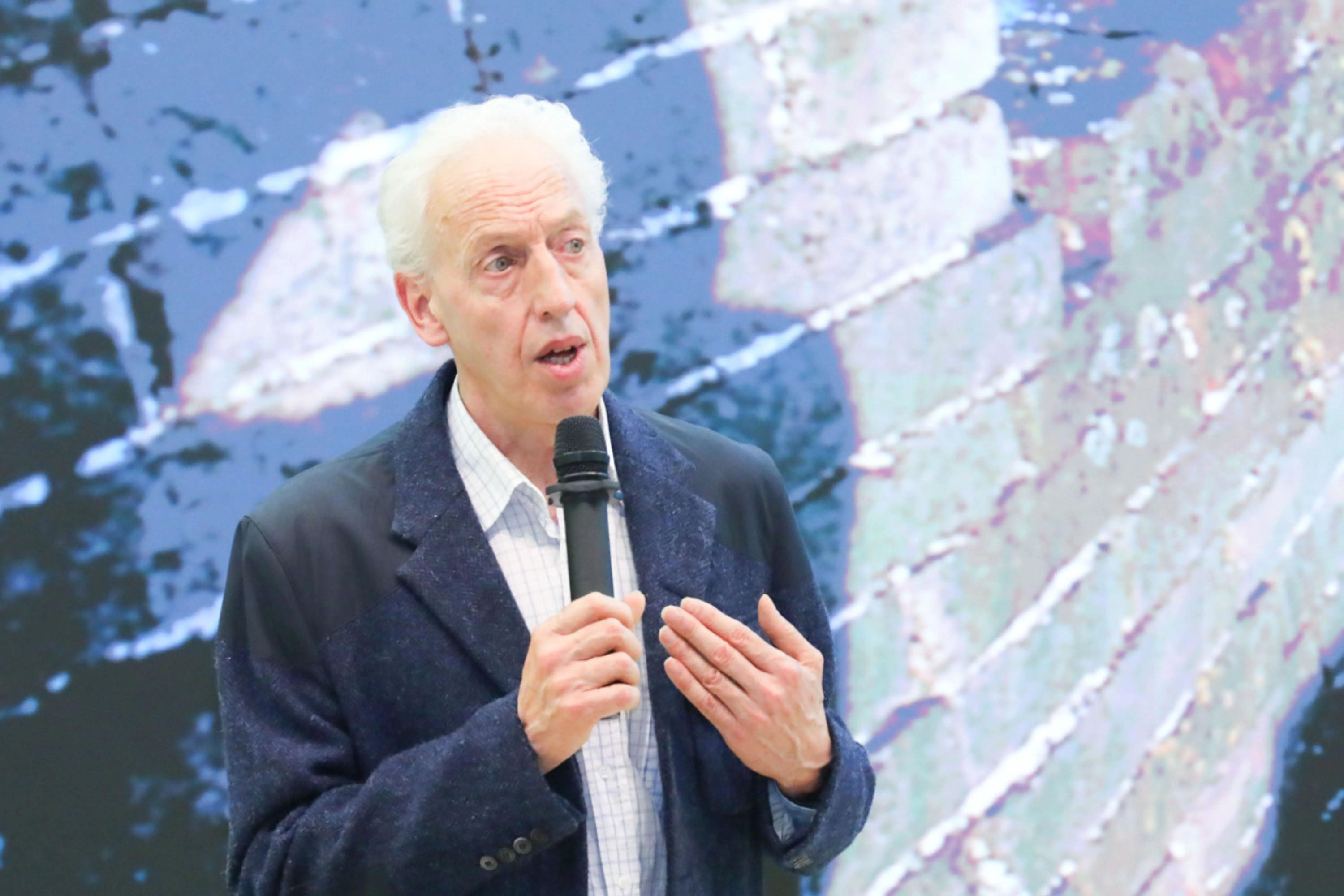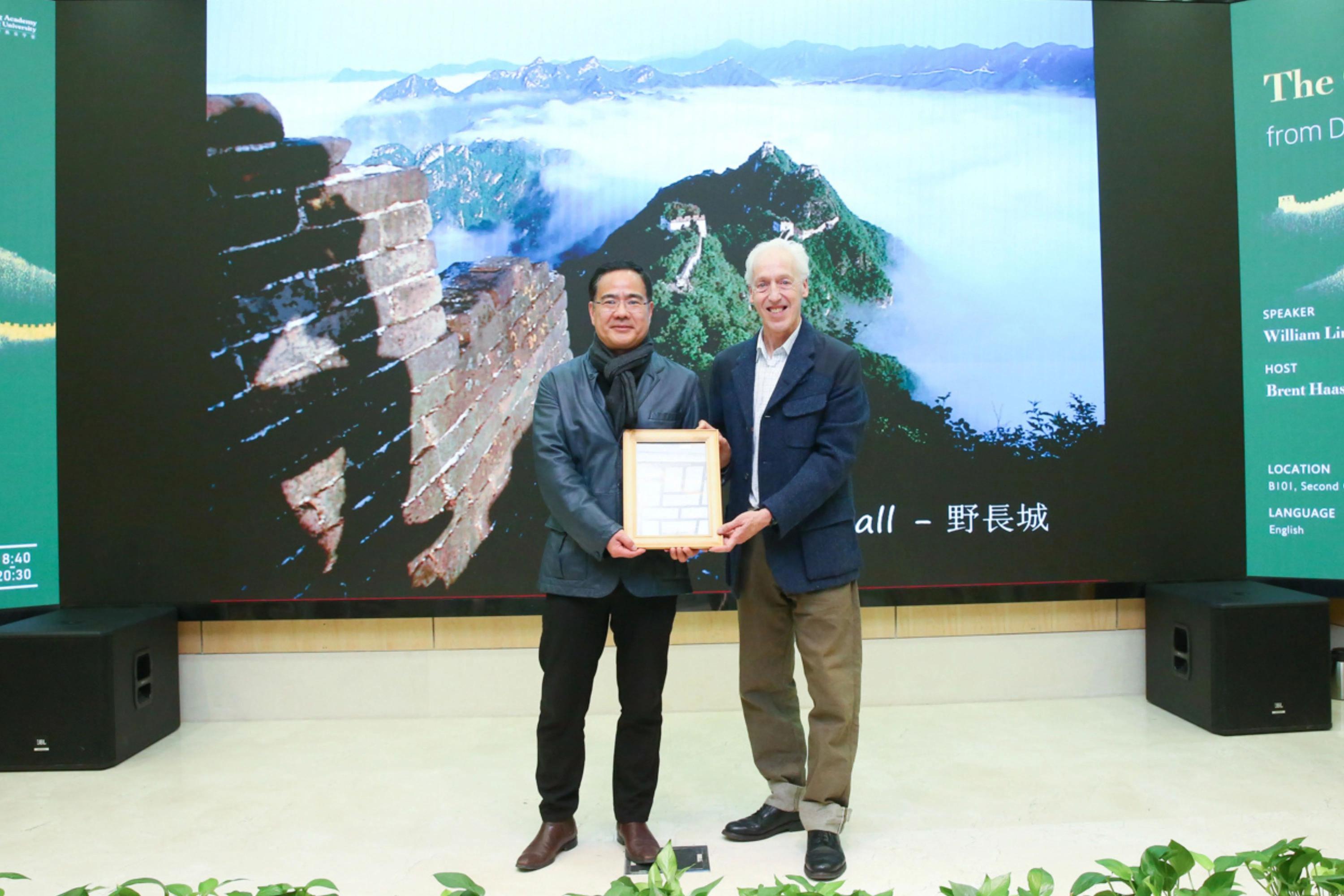On March 6, William Lindesay, a British researcher of the Great Wall and founder of International Friends of the Great Wall, gave a lecture themed “The Great Wall, from Different Directions.” Hosted by YCA Associate Dean Brent Haas, this marked the sixth lecture in the China Studies Lecture Series for the 2023‒2024 academic year.

Interview Notes
Mr. Lindesay sat for an interview before the lecture, discussing conservation efforts for the Great Wall since 1998. He stated that “… in the 80s and the 90s, Great Wall conservation was limited… focusing on the reconstruction of a few sections along the whole length of the Ming dynasty Great Wall, for example, Badaling, Mutianyu, Jinshanling, Shanhaiguan, and Jiayuguan. He noted significant progress since 2003, when Beijing municipal authorities issued regulations to protect the Great Wall, and the Central Government’s directive that every province along the Ming Dynasty Great Wall send archaeologists to find the remains of the Ming Wall. Surveyors plotted the location and measured the length of the ruins, leading to a comprehensive survey of Ming dynasty wall remains. This survey, completed before the 2008 Beijing Summer Olympics, revealed a staggering length of 8,851 kilometers of Ming Wall remains. Mr. Lindesay emphasized how the grand survey spurred competition among provinces to stake out each strand of the Great Wall over which they had jurisdiction. He also highlighted ongoing efforts in provinces like Ningxia and Gansu, where protective measures such as plaques with the words “Changcheng” (Great Wall) and restrictions on activities like grazing and dumping have been implemented.
Mr. Lindesay then talked about social media’s impact on Great Wall conservation. “The new technologies we have nowadays are ‘double-edged swords.’ Take social media, for example; it’s been great that more people have discovered the wonder of the Great Wall because I believe without knowledge, you will not have the appreciation of the wonderful human stories that the Great Wall contains, and without that appreciation, you won’t have voluntary conservation… However, social media has unleashed large numbers of people with low environmental awareness and a willingness to protect ancient relics. They’ve arrived at the Wall, left their litter, used magic markers to write their names on the bricks, and so on.”
Reflecting on his personal connection to the Great Wall, Mr. Lindesay shared his lifelong fascination, tracing back to childhood when he first encountered it on a map of China in the atlas beside his bed. Mr. Lindesay nicknamed the Hadrian’s Wall in Britain “Baili Changcheng” (A Hundred-li Wall), contrasting the Great Wall or “Wanli Changcheng” (Ten-thousand-li-long Wall) in China.
He underscored how his exploration of the Great Wall was inspired by his experience running along Hadrian’s Wall in Britain in 1984, leading him to embark on his journey along the Great Wall, which “has been continuous, natural, and organic.” Also, Mr. Lindesay noted drawing on his endurance and fortitude gained from being a long-distance athlete, enabling him to sustain his intellectual and practical journey along the Great Wall and maintain focus.
Review of the Lecture
Mr. Lindesay opened his lecture with an overview of the Great Wall’s construction in the framework of Chinese history from the 14th to 17th centuries, calling the monument “the classical wall of the dragon” to stress its impressive length of 8,851 kilometers. Mr. Lindesay noted that the Great Wall is by no means a single building; instead, it had been built and rebuilt by different dynastic rules in succession throughout China’s history spanning thousands of years. He showed our Scholars several maps of the Great Wall across Chinese territory, constructed in different historical periods, with various materials, and for distinct purposes.


Mr. Lindesay shifted the focus to the Great Wall’s origin, dating back to 300 BCE when conflicts erupted between the settled agrarian society and surrounding nomadic tribes during the Warring States period. He elaborated on both sides’ military tactics, including developing compound bows and constructing defensive structures. Mr. Lindesay explained how successive Chinese dynasties expanded and reinforced the Great Wall, incorporating it into their defense strategies.

The Great Wall comprises numerous significant segments, exemplified by the well-preserved remains of the first strand of the Great Wall north of Beijing. He discussed the Western Han court’s Great Wall construction efforts to protect the Silk Road and other trade routes of the time, illustrating his points with historical photographs. Mr. Lindesay touched upon cultural exchanges between China and other countries, including the first British mission to China in 1793, highlighting the significance of watercolors and sculptures created by the mission members. He explained that those artworks provided images of the Great Wall at the time.
Reflecting on his personal experiences, including running along the Great Wall and encountering diverse cultures, Mr. Lindesay recounted his initial exposure to the Chinese language in Liverpool's Chinatown. He shared his initial shock at the linguistic disparities between English and Chinese upon arriving in Beijing in 1986, admitting to pre-trip apprehensions that ultimately transformed into a rewarding adventure. He compared his experiences with those of William Edgar Geil, the renowned American traveler who led the first expedition of the Great Wall in 1908 and wrote a book about the Great Wall. He also discussed what he had gained from his “adventure journey” along the Great Wall.

In the last part of his lecture, Mr. Lindesay outlined his conservation efforts for the Great Wall. He has initiated volunteer cleanup and maintenance projects of different sections of the Great Wall to raise awareness of the Great Wall’s historic significance and the importance of environmental protection. His endeavors have been more than physical protection. Mr. Lindesay has also been engaged in cultural and academic endeavors to conserve the Great Wall, facilitating channels for international collaboration and authoring books on the Great Wall. He highlighted that global cooperation and public participation are crucial for preserving the historic landmark.

Q&A Time
Q: What is the “conservation” of the Great Wall?
A: A few kilometers of the Great Wall within Beijing’s jurisdiction have been reinforced in recent years. I love ruins and walls hidden in wild grass because they symbolize ageing, like wrinkles and grey hair. However, some parts of the Great Wall need our intervention, such as beacon structures, whose gateways and arches are built with bricks and are prone to fall off in bad weather. Also, vulnerable segments of the Wall may collapse during an earthquake or erosion. In the western provinces, strands of the Great Wall are largely made of rammed earth and comparatively soft. It is dry in the provinces, but rain has washed away the earth. In some places, efforts to reinforce rammed earth sections are underway. We’ve worked hard against catastrophic natural disasters. The conservation of the Great Wall is, of no doubt, one of the most significant projects of the kind in the world.